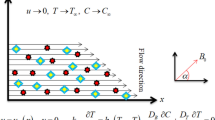Abstract
L'étude de transfert de matière dans un liquide traversant un tube cylindrique sous un régime d'écoulement pulsé a été d'abord menée expérimentalement pour différentes valeurs de paramètres caractérisant les conditions hydrodynamiques et en mettant en oeuvre a réduction électrochimique de l'ion ferricyanure à une électrode de nickel dans la soude 1m. L'expérience montre que la surimposition de la pulsation à l'écoulement permanent favorise le transfert de matière à la paroi et améliore donc la productivité du réacteur électrochimique. Il est également à noter que cette amélioration est d'autant plus importante que la vitesse moynne de percolation est initialement faible. Par ailleurs, l'amplitude de pulsation et la fréquence jouent des rôles équivalents dans ce pocessus. Nous proposons dans cet article une solution analytique approchée à l'équation de diffusion-convection. Elle permet de prévoir l'accroissement de courant par rapport au régime d'écoulement stationnaire. Les résultats théoriques et expérimentaux s'accordent d'une manière assez satisfaisante.
Mass transfer in a pulsed liquid flowing through a cylindrical tube, which constitutes the cathode of an electrochemical reactor, is studied for different values of the parameters characterising the hydrodynamic conditions. The reduction of the hexacyanoferrate(III) ion in 1m sodium hydroxide at a nickel cathode is used. The experiments show that superimposing pulsation on a mean steady flow enhances the mass transfer rate at the wall and this increases the reactor productivity. Furthermore, we have noticed that the smaller the initial mean flow rate, the greater the enhancement. On the other hand, we have also noticed that amplitude and frequency of the pulsation play similar roles. Finally, an approximate analytical solution proposed for the convection–diffusion equation allows prediction of the extent of mass transfer enhancement with pulsation parameters. The agreement between this prediction and experimental data is satisfactory.
Similar content being viewed by others
Références
H. Olive–Contribution au développement des électrodes volumiques Thèse de Docteur-Ingénieur de l'INP Toulouse, France (1978).
H. Olive and G. Lacoste, L’onde électrique 59 (1979) 91.
E. B. Fagela-Alabastro and J. Hellums, AIChE J. 15 (1969) 164.
G. Fortuna and T. J. Hanratty, Int. J. Heat Mass Transfer 14 (1971) 1499.
W. J. Mc. Michael and J. D. Hellums. AIChE J. 21 (1975) 743.
T. J. Pedley, J. Fluid Mech. 78 (1976) 513.
R. D. Patel, J. J. Mac Feeley and K. R. Jolls, AIChE J. 21 (1975) 259.
R. C. Ackerberg, R. D. Patel and S. K. Gupta, J. Fluid Mech. 86 (1978) 49.
R. C. Martinelli, L. M. Boelter, E. B. Weinberg and S. Yakahi, Trans. ASME 65 (1943) 789.
R. Lemlich, Chem. Eng. 68 (1961) 171.
F. B. West and A. T. Taylor, Chem. Eng. Progress. 48 (1952) 39.
W. K. Mueller, Proc. Fifth Midwestern Conf. Fluid Mech., Ann Arbor (1957) 146.
G. B. Darling, Petroleum 22 (1959) 177.
M. Faghri, K. Javdani and A. Faghri, Lett. Heat Mass Trans. 6 (1979) 259.
O. E. Karamercan and J. Gainer, Ind. Eng. Chem. Fundam. 18 (1979) 12.
S. K. Gupta, R. Patel and R. Ackerberg, Chem. Eng. Sci. 37 (1982) 1727.
R. D. Saylor and J. Berman, Chem. Eng. Comm. 52 (1987) 215.
D. J. Tagg, M. A. Patrick and A. A. Wragg, Trans. IChemE 57 (1979) 12.
A. Ratel, Etude des réacteurs électrochimiques à électrodes poreuses percolées par un écoulement pulsé. Thése d’état-INP Toulouse France (1987).
M. Baird, G. Duncan, J. Smith and J. Taylor, Chem. Eng. Sci. 21 (1966) 97.
P. Lambossy, Helv. Physica Acta 25 (1952) 371.
J. R. Womersley, J. Physiol. 127 (1955) 553.
H. Schlichting, ‘Boundary Layer Theory’, McGraw–Hill, New York (1968).
N. Gastinel, ‘Mathématiques pour l’informatique’, Armand Colin, Paris (1970).
A. Ratel, P. Duverneuil et G. Lacoste, J. Appl. Electrochem. 18 (1988) 394.
Author information
Authors and Affiliations
Rights and permissions
About this article
Cite this article
Gadri, A., Ratel, A. & Lacoste, G. Influence des parametres hydrodynamiques sur le transfert de matiere dans un liquide en ecoulement pulsé dans une cathode cylindrique. Journal of Applied Electrochemistry 28, 921–928 (1998). https://doi.org/10.1023/A:1003440525986
Issue Date:
DOI: https://doi.org/10.1023/A:1003440525986




